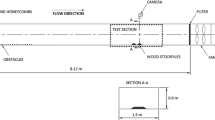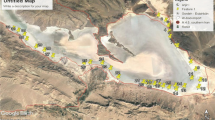Abstract
The importance of open mineral storage piles in bulk solids port terminals have increased considerably in recent years in Europe and USA (in Spain, great extensions of transoceanic ports are being made) to address the increasing demand of raw material importation due to local mining operation closure. These storage piles are affected by the climatologically processes and the dust emission to the atmosphere, causing repercussions to health and environmental, which is intimately related to the air velocity, according to USEPA studies, maximum ratio of dust emission emitted from CFD and software Ansys CFX 10.0 is determined. In addition, an emission variability study based on the pile distance of different height solid barriers is developed, reducing the emission to 66%. The studies have been contrasted by published investigations and industrial measurement.
Similar content being viewed by others
References
Page SJ, Organiscak JA (2004) Semi-empirical model for predicting surface coal mine drill respirable dust emission. Int J Surf Min Reclam Environ 18(1): 42–59. doi:10.1076/ijsm.18.1.42.23546
ANSYS CFX- Solver. Release 10.0 ANSYS CFX-Solver (2008), Release 10.0: Modelling, pp 327
Chang WR (2006) Effect of porous hedge on cross ventilation of a residential building. Build Environ 41: 549–556. doi:10.1016/j.buildenv.2005.02.032
Lee SJ, Parkb KC, Parka CW (2002) Wind tunnel observations about the shelter effect of porous fences on the sand particle movements. Atmos Environ 36: 1453–1463. doi:10.1016/S1352-2310(01)00578-7
Lee SJ, Kim HB (1999) Laboratory measurements of velocity and turbulence field behind porous fences. J Wind Eng Ind Aerodyn 80: 311–326
Minvielle F, Marticorena B, Gillette DA, Lawson RE, Thompson R, Bergametti G (2003) Relationship between the aerodynamic roughness length and the roughness density in cases of low roughness density. Environ Fluid Mech 3: 249–267. doi:10.1023/A:1022830119554
US EPA Sections 13.2.4 and 13.2.5 (1988) Compilation of air pollutant emission factors
Moloney KM, Lowndes IS, Hargrave GK (1999) Analyzes of flow patterns in drivages with auxiliary ventilation. Trans Inst Min Metall 108: 17–26
Wala A, Jacob J, Brown J, Huang G (2003) New approaches to mine-face ventilation. Min Eng 55(3): 25–30
Moloney KM, Lowndes IS (2004) Comparison of measured underground air velocities and air flows simulated by computational fluid dynamic. Trans Inst Min Metall 108: 105–114
Toraño J, Rodriguez R, Diego I, Rivas JM, Pelegry A (2007) Influence of the pile shape on wind erosion CFD emission simulation. Appl Math Model 31: 2487–2502. doi:10.1016/j.apm.2006.10.012
Diego I, Pelegry A, Torno S, Toraño J, Menendez M (2008) Simultaneous CFD evaluation of wind flow and dust emission in open. Appl Math Model 33: 3197–3207
Silvester SA, Lowndes IS, Kingman SW (2004) The ventilation of an underground crushing plant. Min Technol Trans Inst Min Metall A 113: 201–214
Parsons, Walker, Wiggs (2004) Numerical modelling of flow structures over idealized transverse aeolian dunes of varying geometry. Geomorphology 59: 149–164. doi:10.1016/j.geomorph.2003.09.012
Hayden KS, Park K, Curtir JS (2003) Effect of particle characteristics on particle pickup velocity. Powder Technol 131: 7–14. doi:10.1016/S0032-5910(02)00135-3
Stunder BJB, Arya SPS (1988) Windbreak effectiveness for storage piles fugitive dust control: a wind tunnel study. J Air Pollut Control Assoc 38: 135–143
Frank C, Runk B (2005) Double-arranged mound-mounted shelterbelts: influence of porosity on wind reduction between the shelters. Environ Fluid Mech 5: 267–292. doi:10.1007/s10652-004-3820-2
Author information
Authors and Affiliations
Corresponding author
Rights and permissions
About this article
Cite this article
Toraño, J., Torno, S., Diego, I. et al. Dust emission calculations in open storage piles protected by means of barriers, CFD and experimental tests. Environ Fluid Mech 9, 493–507 (2009). https://doi.org/10.1007/s10652-009-9136-5
Received:
Accepted:
Published:
Issue Date:
DOI: https://doi.org/10.1007/s10652-009-9136-5




